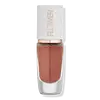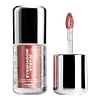What's inside
What's inside
 Key Ingredients
Key Ingredients

 Benefits
Benefits

 Concerns
Concerns

 Ingredients Side-by-side
Ingredients Side-by-side

Water
Skin ConditioningSynthetic Fluorphlogopite
PEG-11 Methyl Ether Dimethicone
EmulsifyingPropanediol
SolventCalcium Aluminum Borosilicate
Diglycerin
HumectantMica
Cosmetic ColorantSilica
AbrasiveGlycerin
HumectantRosa Damascena Flower Water
MaskingPentylene Glycol
Skin Conditioning1,2-Hexanediol
Skin ConditioningCalcium Chloride
AstringentPolyvinyl Alcohol
PEG-240
HumectantLithium Magnesium Sodium Silicate
AbsorbentPhenoxyethanol
PreservativePPG-26-Buteth-26
Skin ConditioningXanthan Gum
EmulsifyingPEG-40 Hydrogenated Castor Oil
EmulsifyingTin Oxide
AbrasiveDisodium EDTA
Butylene Glycol
HumectantCitric Acid
BufferingPotassium Sorbate
PreservativeSodium Alum
AstringentWater, Synthetic Fluorphlogopite, PEG-11 Methyl Ether Dimethicone, Propanediol, Calcium Aluminum Borosilicate, Diglycerin, Mica, Silica, Glycerin, Rosa Damascena Flower Water, Pentylene Glycol, 1,2-Hexanediol, Calcium Chloride, Polyvinyl Alcohol, PEG-240, Lithium Magnesium Sodium Silicate, Phenoxyethanol, PPG-26-Buteth-26, Xanthan Gum, PEG-40 Hydrogenated Castor Oil, Tin Oxide, Disodium EDTA, Butylene Glycol, Citric Acid, Potassium Sorbate, Sodium Alum
Water
Skin ConditioningMica
Cosmetic ColorantCalcium Aluminum Borosilicate
Xanthan Gum
EmulsifyingSqualane
EmollientAcrylates Copolymer
Polysorbate 20
EmulsifyingTriethanolamine
BufferingHyaluronic Acid
HumectantPropanediol
SolventAloe Barbadensis Flower Extract
EmollientPhenoxyethanol
PreservativeTin Oxide
AbrasiveCentella Asiatica Leaf Extract
Skin ConditioningChamomilla Recutita Flower Extract
Masking1,5-Pentanediol
SolventHydroxyacetophenone
Antioxidant1,2-Hexanediol
Skin ConditioningCI 77491
Cosmetic ColorantCI 77891
Cosmetic ColorantWater, Mica, Calcium Aluminum Borosilicate, Xanthan Gum, Squalane, Acrylates Copolymer, Polysorbate 20, Triethanolamine, Hyaluronic Acid, Propanediol, Aloe Barbadensis Flower Extract, Phenoxyethanol, Tin Oxide, Centella Asiatica Leaf Extract, Chamomilla Recutita Flower Extract, 1,5-Pentanediol, Hydroxyacetophenone, 1,2-Hexanediol, CI 77491, CI 77891
Ingredients Explained
These ingredients are found in both products.
Ingredients higher up in an ingredient list are typically present in a larger amount.
1,2-Hexanediol is a synthetic liquid and another multi-functional powerhouse.
It is a:
- Humectant, drawing moisture into the skin
- Emollient, helping to soften skin
- Solvent, dispersing and stabilizing formulas
- Preservative booster, enhancing the antimicrobial activity of other preservatives
Calcium Aluminum Borosilicate is made up of calcium, aluminum, and silicates. It is a glass-like material. In cosmetics, it comes in the form of flakes or microspheres.
Calcium aluminum borosilicate is a bulking agent, meaning it helps thicken a product.
This ingredient is created by slowly mixing several minerals, including kaolin clay.
Although “aluminum” in an ingredient name can raise red flags for some consumers, the form and usage context matter significantly. For typical topical applications, there is no substantial evidence of health risks - such as cancer, neurotoxicity, or systemic “aluminum overload.”
Learn more about Calcium Aluminum BorosilicateMica is a naturally occurring mineral used to add shimmer and color in cosmetics. It can also help improve the texture of a product or give it an opaque, white/silver color.
Serecite is the name for very fine but ragged grains of mica.
This ingredient is often coated with metal oxides like titanium dioxide. Trace amounts of heavy metals may be found in mica, but these metals are not harmful in our personal products.
Mica has been used since prehistoric times throughout the world. Ancient Egyptian, Indian, Greek, Roman, Aztec, and Chinese civilizations have used mica.
Learn more about MicaPhenoxyethanol is a preservative that has germicide, antimicrobial, and aromatic properties. Studies show that phenoxyethanol can prevent microbial growth. By itself, it has a scent that is similar to that of a rose.
It's often used in formulations along with Caprylyl Glycol to preserve the shelf life of products.
Propanediol is an all-star ingredient. It softens, hydrates, and smooths the skin.
It’s often used to:
Propanediol is not likely to cause sensitivity and considered safe to use. It is derived from corn or petroleum with a clear color and no scent.
Learn more about PropanediolTin Oxide is an inorganic oxide used to add opacity and volume to a product. In nature, it is already found in mineral form. The main ore of tin is an opaque and shiny mineral called casseterite.
Tin Oxide helps remove translucency in a product, or make it more opaque. Besides adding opacity, tin oxide is used for bulking to add volume.
Water. It's the most common cosmetic ingredient of all. You'll usually see it at the top of ingredient lists, meaning that it makes up the largest part of the product.
So why is it so popular? Water most often acts as a solvent - this means that it helps dissolve other ingredients into the formulation.
You'll also recognize water as that liquid we all need to stay alive. If you see this, drink a glass of water. Stay hydrated!
Learn more about WaterXanthan gum is used as a stabilizer and thickener within cosmetic products. It helps give products a sticky, thick feeling - preventing them from being too runny.
On the technical side of things, xanthan gum is a polysaccharide - a combination consisting of multiple sugar molecules bonded together.
Xanthan gum is a pretty common and great ingredient. It is a natural, non-toxic, non-irritating ingredient that is also commonly used in food products.
Learn more about Xanthan Gum